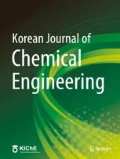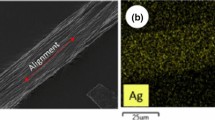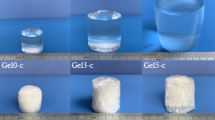Abstract
Bacterial cellulose-chitosan composites (BC-Ch) were prepared in order to obtain the BC-Ch composites with improved physico-mechanical characteristics. BC sheets were immersed in a Ch solution hoping that the Ch penetrates into the BC sheet. Ch penetration was observed according to variations in temperature, operation mode and treatment time. The morphological changes due to enhanced penetration were observed through FE-SEM, FT-IR and XRD analysis. FE-SEM analyses confirmed the formation of three dimensional multilayered structures in BC-Ch, whose thickness increased with Ch penetration. The FT-IR analysis showed intermolecular hydrogen bonding interaction between the BC and Ch molecules. XRD results revealed a slight decrease in the crystallinity index of the BC-Ch composites compared to pure BC. The mechanical properties, water holding capacity (WHC) and water release rate (WRR) of the BC-Ch composites were significantly improved compared to pure BC. The superior mechanical properties, WHC and water release rate would make the BC-Ch composites suitable for wound dressing and other biomedical applications.
Similar content being viewed by others
References
L. J. Chien, H. T. Chen, P. Fen. Yang and C. K. Lee, Biotechnol. Prog., 22, 1598 (2006).
A. M. Sokolnicki, R. J. Fisher, T. P. Harrah and D. L. Kaplan, J. Membr. Sci., 272, 15 (2006).
O. Shezad, S. Khan, T. Khan and J. K. Park, Korean J. Chem. Eng., 26, 1689 (2009).
P. Ross, R. Mayer and M. Benziman, Microbiol. Rev., 55, 35 (1991).
H. J. Song, H. J. Li, H. Seo, M. J. Kim and S. J. Kim, Korean J. Chem. Eng., 26, 141 (2009).
R. E. Cannon and S. M. Anderson, Microbiol., 17, 435 (1991).
C. N. Choi, H. J. Song, M. J. Kim, M. H. Chang and S. J. Kim, Korean J. Chem. Eng., 22, 1598 (2009).
J. D. Fontana, A. M. De Souza, C.K. Fontana and I. L. Torriani, Biochem. Biotechnol., 24/25, 253 (1990).
L. F. X. Farah, US Patent 4 (1990).
D. Ciechañska, FIBRES & TEXTILES in Eastern Europe, 12, 48 (2004).
J. Kim, Z. Cai, H. S. Lee, G. S. Choi, D. H. Lee and C. Jo, J. Polym. Res., DOI: 10.1007/s10965-010-9470-9.
S. Hirano, H. Seino, I. Akiyama and I. Nonaka, Chitosan: a biocompatible material for oral and intravenous administrationIn: Gebelein, C.G., Dunn, R. L. (Eds.), Progress in Biomedical Polymers, Plenum Press, New York (1990).
H. Takeuchi, H. Yamamoto, T. Niwa, T. Hino and Y. Kawashima, Pharm. Res., 13, 896 (1996).
M. Phisalaphong and N. Jatupaiboon, Carbohydr. Polym., 74, 482 (2008).
K.D. Singh and R. R. Alok, Macromol. Chem. Phys., 40, 69 (2000).
W. Xia, P. Liu, J. Zhang and J. Chen, Food Hydrocolloids, 25, 170 (2010).
A. Dufresne, Molecules, 15, 4111 (2010).
C. S. Paula, F. Tischer, M. R. Sierakowski, H. Westfahl Jr. and C. A. Tischer, Biomacromolecules, 11, 1217 (2010).
O. Shezad, S. Khan, T. Khan and J. K. Park, Carbohydr. Polym., 82, 173 (2010).
M. Iguchi, S. Yamanaka and A. Budhiono, J. Mater. Sci., 35, 261 (2000).
J. K. Park, T. Khan and J.Y. Jung, Bacterial cellulose. In G. O. Phillips and P. A. Williams (Eds.), Handbook of hydrocolloids (2nd Ed., pp. 724–739), Cambridge, UK: Woodhead Publishing Limited (2009).
W. Z. Liang, J.Y. Yuan, S. Yi1, D. L. Cong, Y.Y. Chen, S. R. Jia and Y. L Zhou, Bioinformatics and Biomedical Eng., 1 (2009).
Y. Yamada, K. Hoshino and T. Ishikawa, Biosci. Biotechnol. Biochem., 61, 1244 (1997).
L. Yang, W.W. Hsiao and P. Chen, J. Membr. Sci., 197, 185 (2002).
G. Socrates, Infrared and Raman Characteristics Group Frequencies, Third addition, John Willey and Sons, Ltd. England.
L. Segal, J. Creely, A. Martin and C. Conrad, Text. Res. J., 29, 786 (1959).
M. Wada and T. Okano, Cellulose, 4, 221 (1997).
K. C. Cheng, J. M. Catchmark and A. Demirci, Cellulose, 16, 1033 (2009).
H. J. Gwon, Y. M. Lim, S. J. An, M. Y. Youn, S. H. Han, H. N. Chang and Y. C. Nho, Korean J. Chem. Eng., 26, 1686 (2009).
N. Shah, J. H. Ha and J. K. Park, Biotechonol. Bioprocess Eng., 15, 110 (2010).
A. M. A. Nada, M. El-Sakhawy, S. Kamel, M. A. M. Eid and A. M. Adel, Egypt. J. Solids, 28 (2005).
Author information
Authors and Affiliations
Corresponding author
Rights and permissions
About this article
Cite this article
Ul-Islam, M., Shah, N., Ha, J.H. et al. Effect of chitosan penetration on physico-chemical and mechanical properties of bacterial cellulose. Korean J. Chem. Eng. 28, 1736–1743 (2011). https://doi.org/10.1007/s11814-011-0042-4
Received:
Accepted:
Published:
Issue Date:
DOI: https://doi.org/10.1007/s11814-011-0042-4




